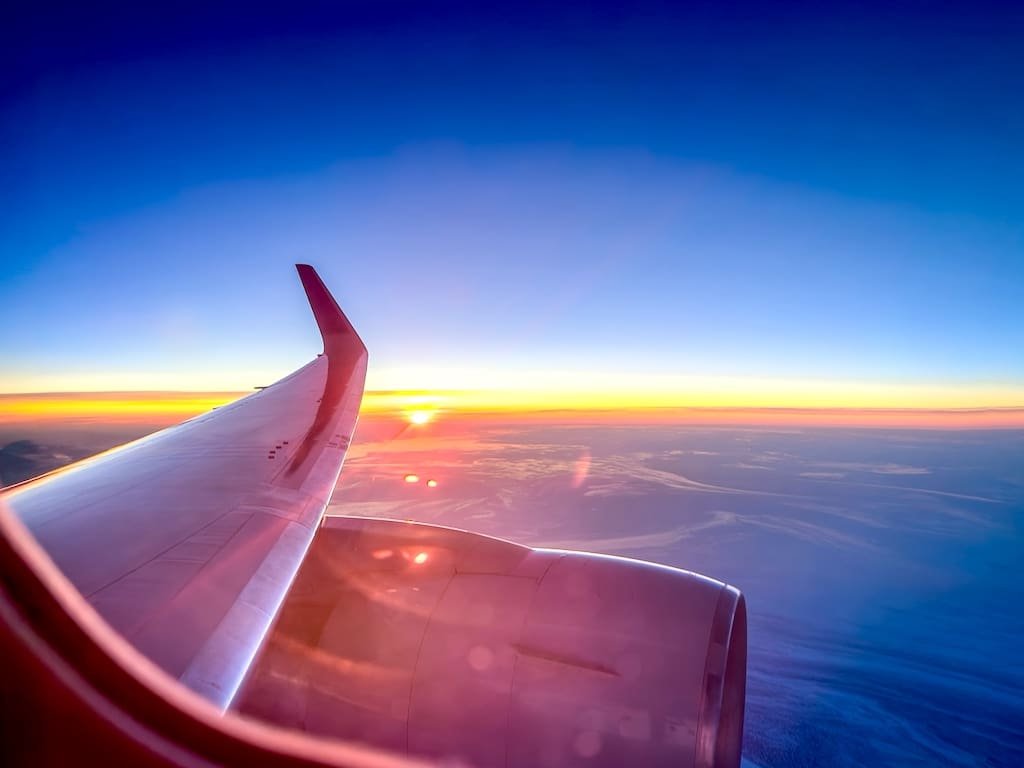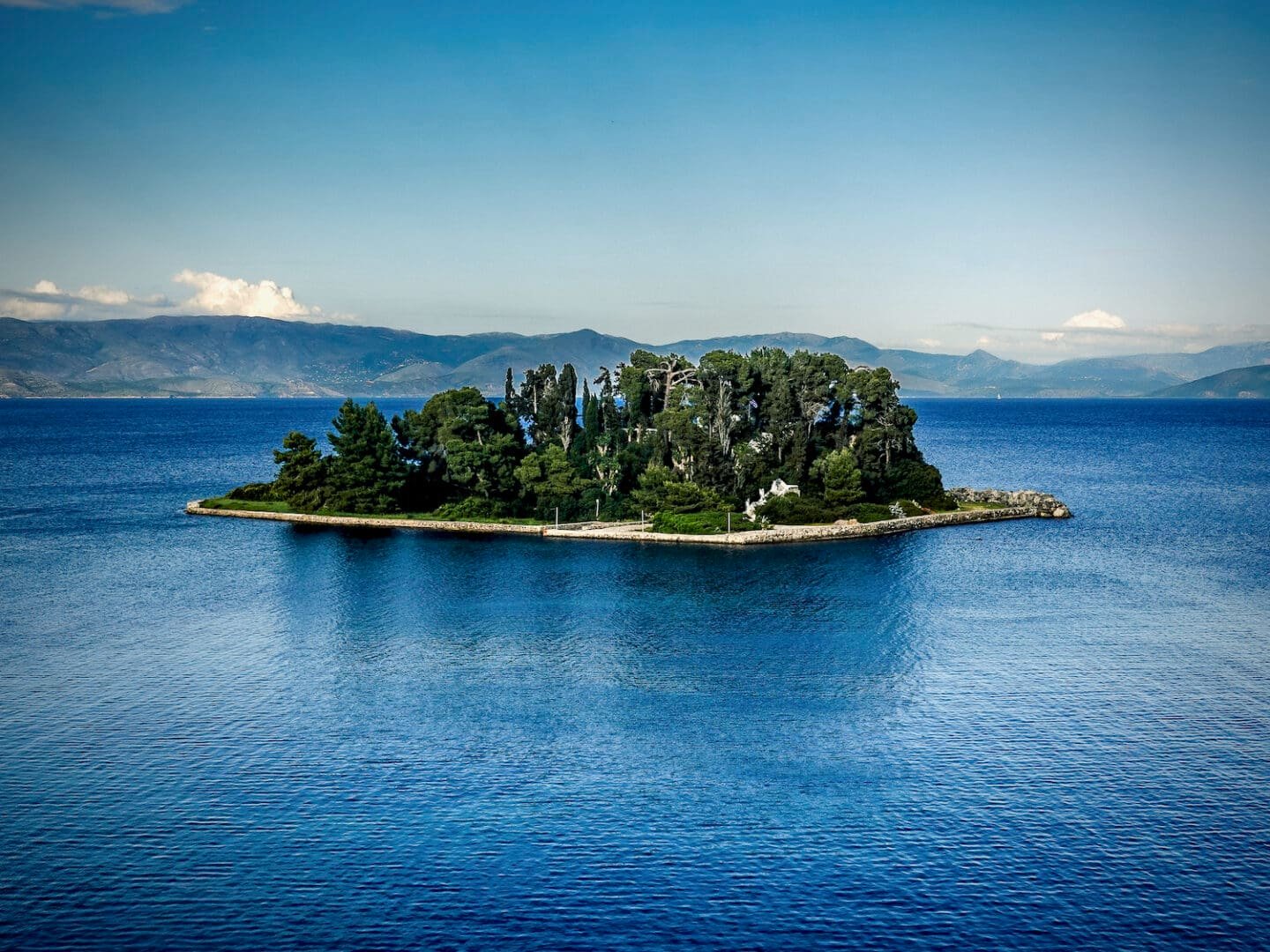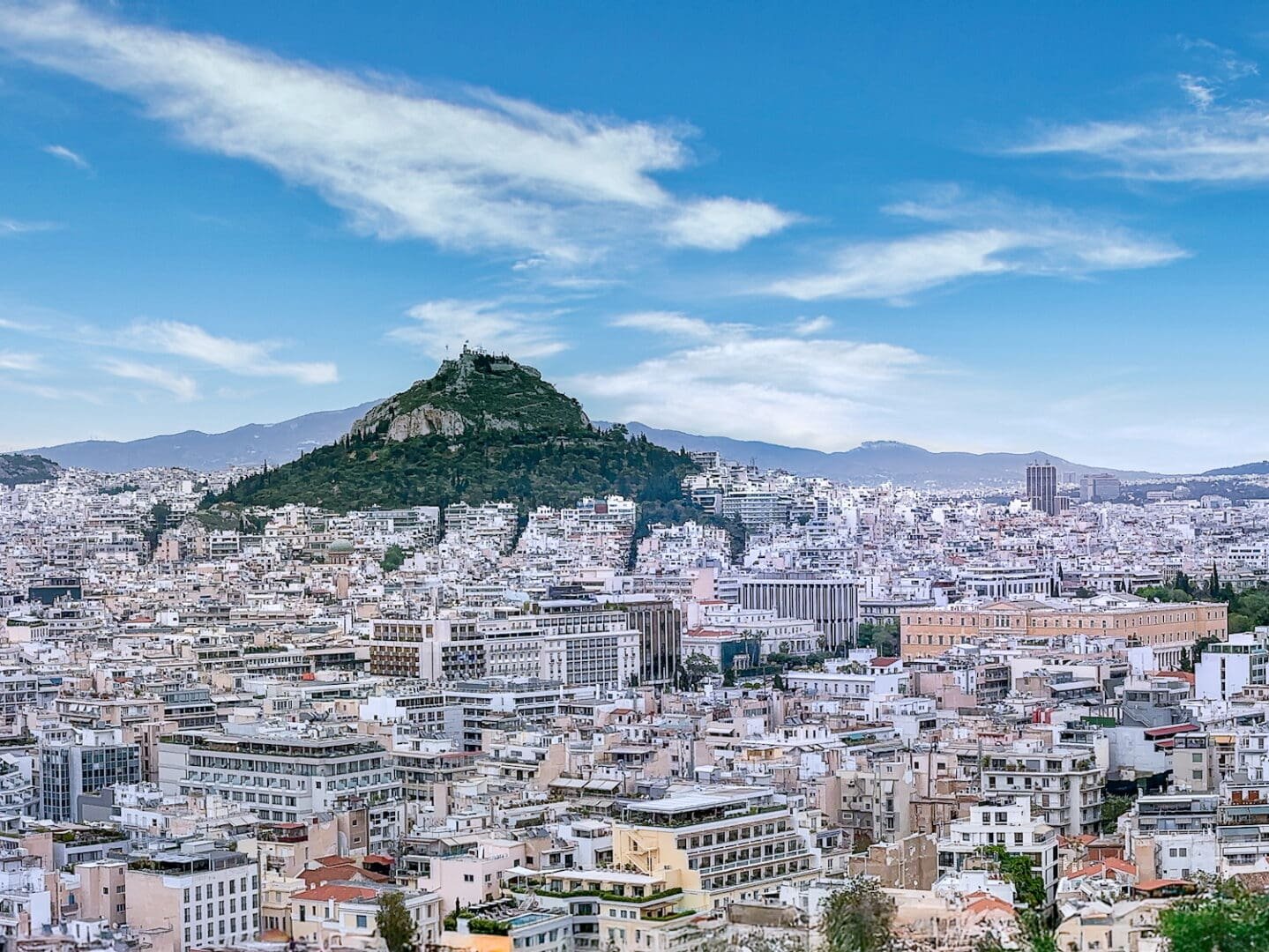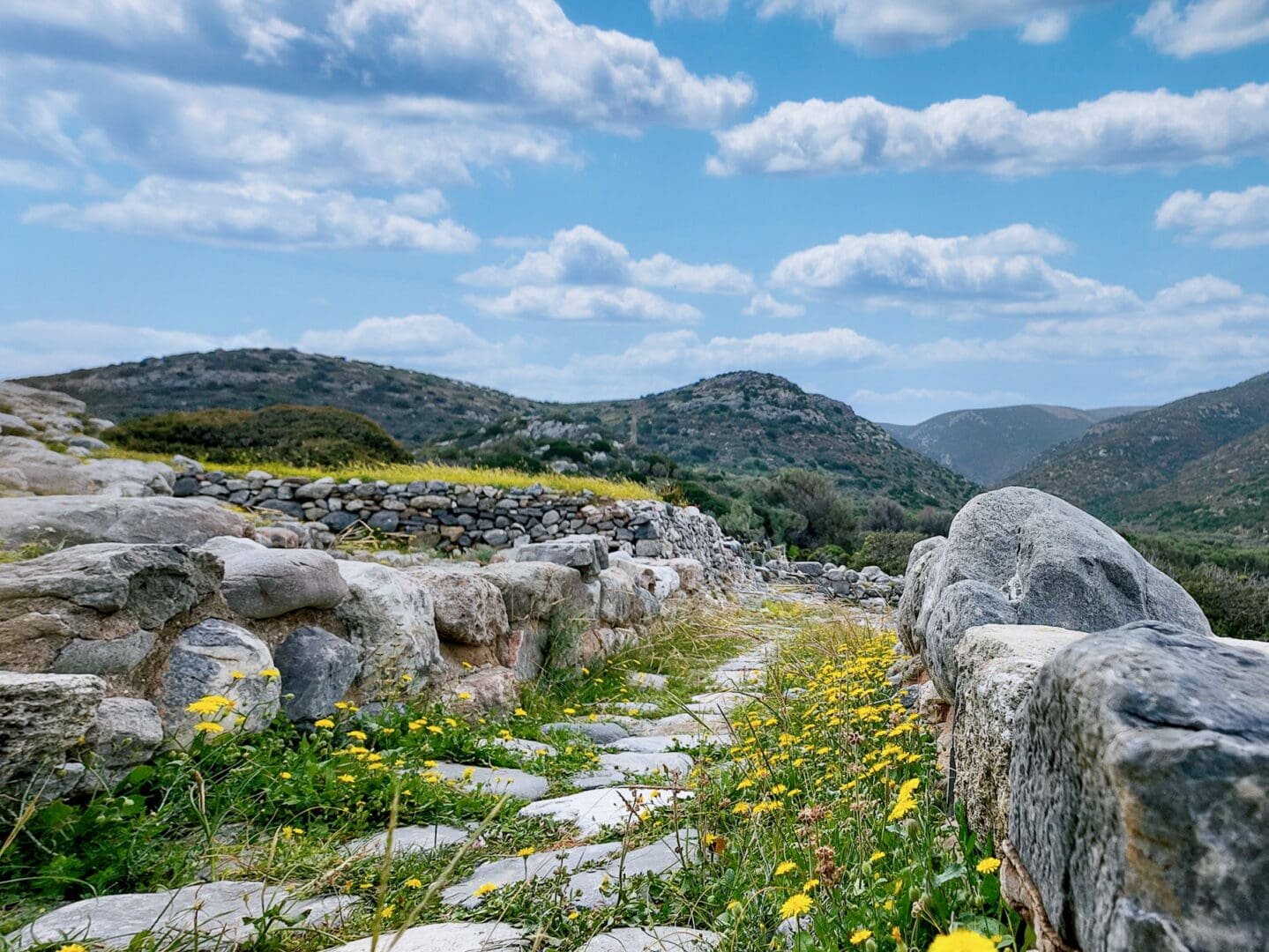
Once upon a time in the late 19th century, Empress Elisabeth of Austria created a palatial retreat, the Achilleion Palace, on the Greek island of Corfu.
Empress Sisi designed the neoclassical mansion and gardens as her private summer residence. She desired a tranquil respite amidst classical art and natural beauty.
Since then, the Achilleion Palace has served different purposes for different owners, including another European monarch.
Today in the 21st century, the royal heritage, romantic ambiance, and melancholy beauty remain distinct at the Achilleion, Corfu.
So let’s discover together the Achilleion Palace, a rare hidden gem on the remarkable Ionian Island of Corfu.
Let’s learn the Achilleion’s imperial history. Explore the enchanting gardens. And reveal some of the artistic treasures.
In this article, you’ll also find custom maps, personal observations, and travel tips from our firsthand experience of slow travel in Greece and the Greek Islands.
Ready? Πάμε, let’s go!
- Map of Corfu, Greece
- Empress Elisabeth of Austria and the Achilleion Palace
- Kaiser Wilhelm II of Germany and the Achilleion Palace
- The Achilleion Palace in the 20th and 21st Centuries
- The Achilleion Palace Imperial Gardens
- Tips to Visit the Achilleion, Corfu
- Interactive Map of Corfu, Greece
- Sources and Resources
- Check Out More Recommendations
- The Achilleion Palace FAQs
When you book or purchase through some links, Spotlight Sojourns may earn a small commission at no extra cost to you. Thanks for using our affiliate links!
Map of Corfu, Greece
The Achilleion Palace is located on the western coast of Corfu, in the Ionian Islands Region of Greece.
The historic estate is secluded in a small village of Gastouri, just off the beaten path from the regional capital, Corfu Town.
To help orient you while reading this article and when planning a trip to Greece, Spotlight Sojourns’ photographer and mapmaker, Paul, has created the custom map above.
Later in this article, you’ll find Paul’s custom interactive map of Corfu. Greece.
Empress Elisabeth of Austria and the Achilleion Palace
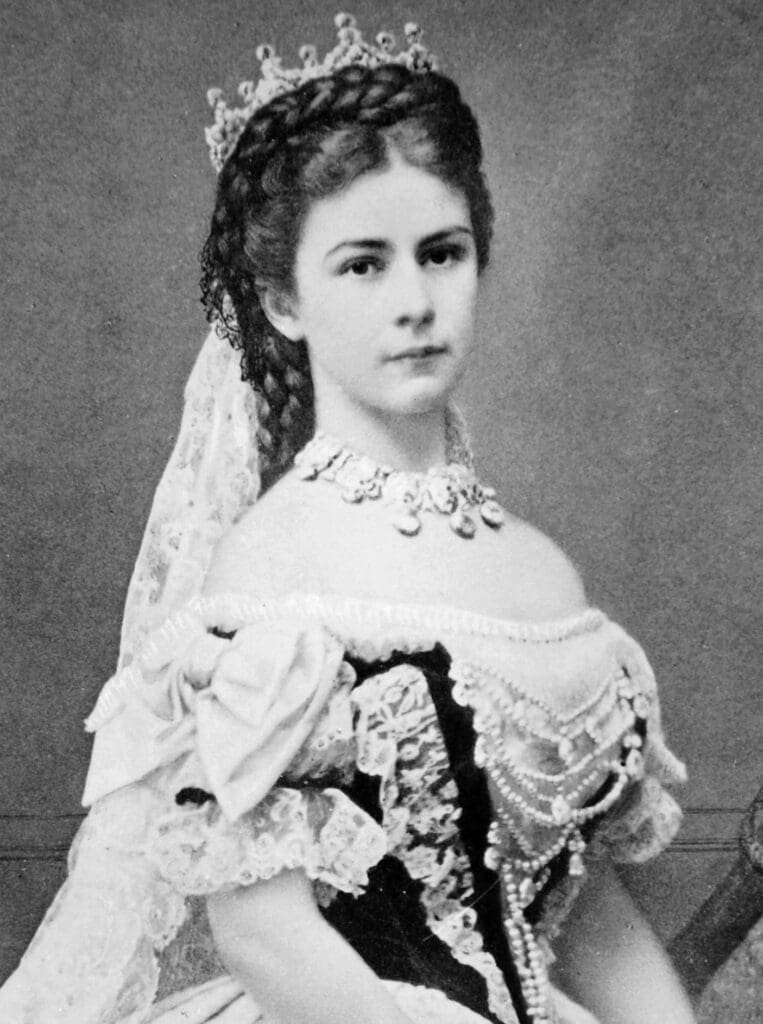
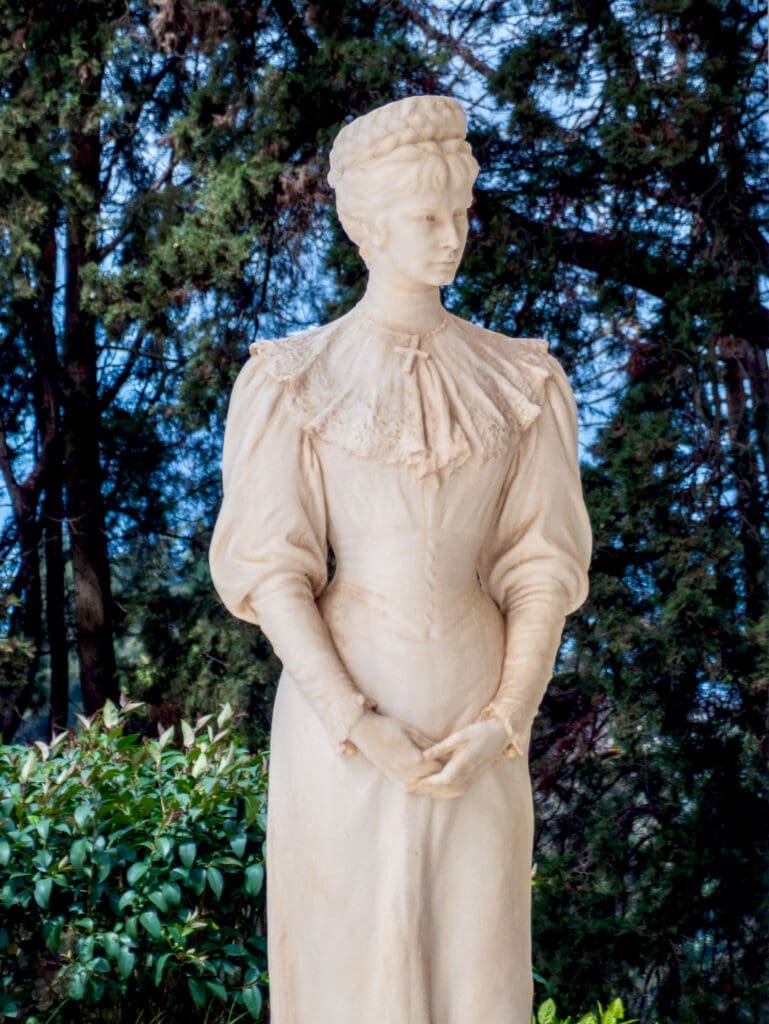
Sisi, otherwise known as Elisabeth, Empress of Austria and Queen of Hungary, had visited Greece and the Greek Islands since her younger years.
It’s easy to imagine that Sisi found the natural beauty and simple charms of the Greek islands to be a literal breath of fresh air.
Especially after the opulent formality and elaborate court ceremony of the Hofburg and Schönbrunn Palaces in Vienna, Austria.
(Not surprisingly, the Hofburg Imperial Apartments, Sisi’s Vienna winter residence, rank among the top attractions in the Austrian capital.)
In 1888, Empress Sisi purchased a picturesque hilltop property from the eminent Vrailas-Armenis family of Corfu.
The idyllic setting features spectacular views overlooking the green Greek island and the turquoise Ionian Sea.
Soon, this bucolic location became a much-needed haven for the middle-aged empress, a mother in search of solace.
Empress Elisabeth, a Grieving Mother
In 1889, Empress Elisabeth and Emperor Franz Joseph I of Austria mourned the heart-breaking sudden loss of their only son and heir to the Habsburg throne, Crown Prince Rudolf.
The grief-stricken mother thus immersed herself in “the white palace she built on Corfu, her place of refuge and seclusion,” Austrian author Stefan Haderer tells the Greek City Times‘ journalist Natalie Martin.
If you’d like to read more about this topic, we recommend Haderer’s deeply researched book, Under the Spell of a Myth: Empress Sisi in Greece.
Empress Sisi, an Icon of Beauty, Art, and Culture
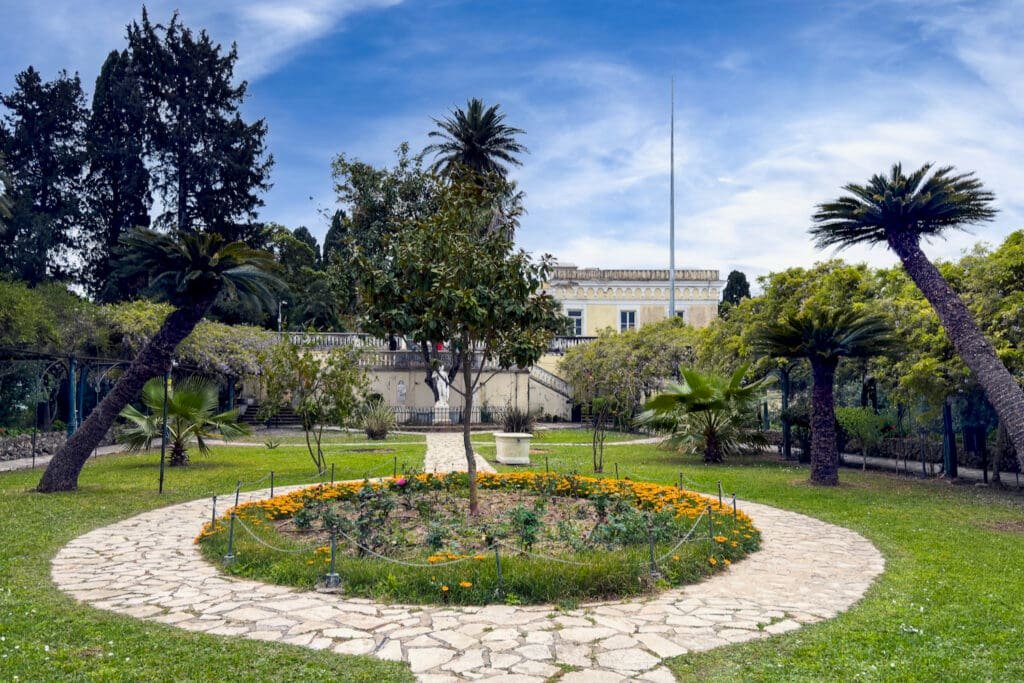
Celebrated for her iconic beauty, Empress Sisi found poetic expression, poignant serenity, and peaceful escape in Greece.
Here at the Achilleion, Empress Sisi’s creative vision and passion for Greek culture, history, mythology, and language blended together in her Greek island estate.
Indeed, Empress Sisi oversaw every aspect of the Achilleion Palace, inside and out, for example,
- Historically inspired architecture of Italian Raffaele Carito.
- Interior design and decorations.
- Garden layout and landscapes.
- Art and sculpture selections.
She even designed a special hallmark, a crowned dolphin, for all the Achilleion furnishings and works of art.
The Achilleion thus became a beautiful and elegant retreat exclusively for the Empress, her two daughters, and her sons-in-law for several years.
Sadly, Sisi never returned to the Achilleion after her last sojourn to Greece in 1896.
Tragically, only two years later, an assassin’s fatal knife took Sisi’s life in Switzerland in 1898.
Like Achilles, whose myth resonates in The Iliad, Sisi’s legendary life evokes a Homeric epic poem.
The Achilleion Palace: Notes on Greek Names
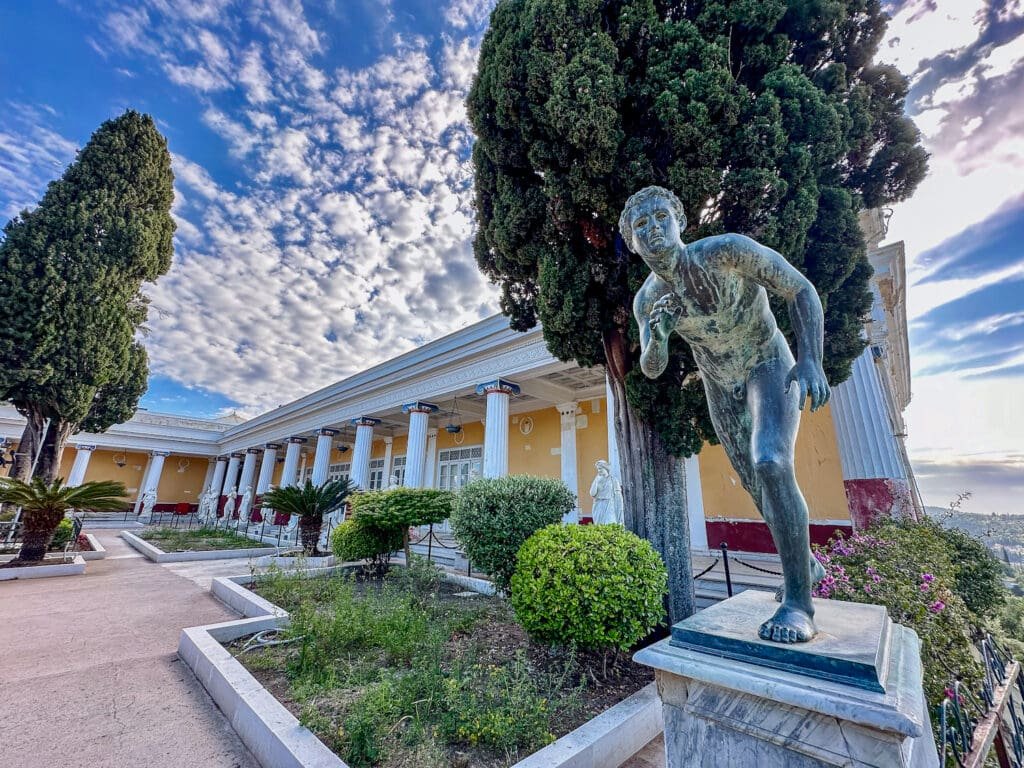
Empress Elisabeth named her Greek residence the Achilleion Palace (Αχίλλειο Ανάκτορο in Greek) in honor of the Ancient Greek mythical hero, Achilles (Ἀχιλλεύς).
Due to various transliterations from Greek to English, an alternative spelling is the Achillion Palace, that is, without the “e.”
Additionally, the village of Gastouri (Γαστούρι) is occasionally spelled as Gasturi, i.e., without the “o.”
Lastly, to clarify, let’s note the Hellenic name for Corfu is Kerkyra (Κέρκυρα).
Kaiser Wilhelm II of Germany and the Achilleion Palace
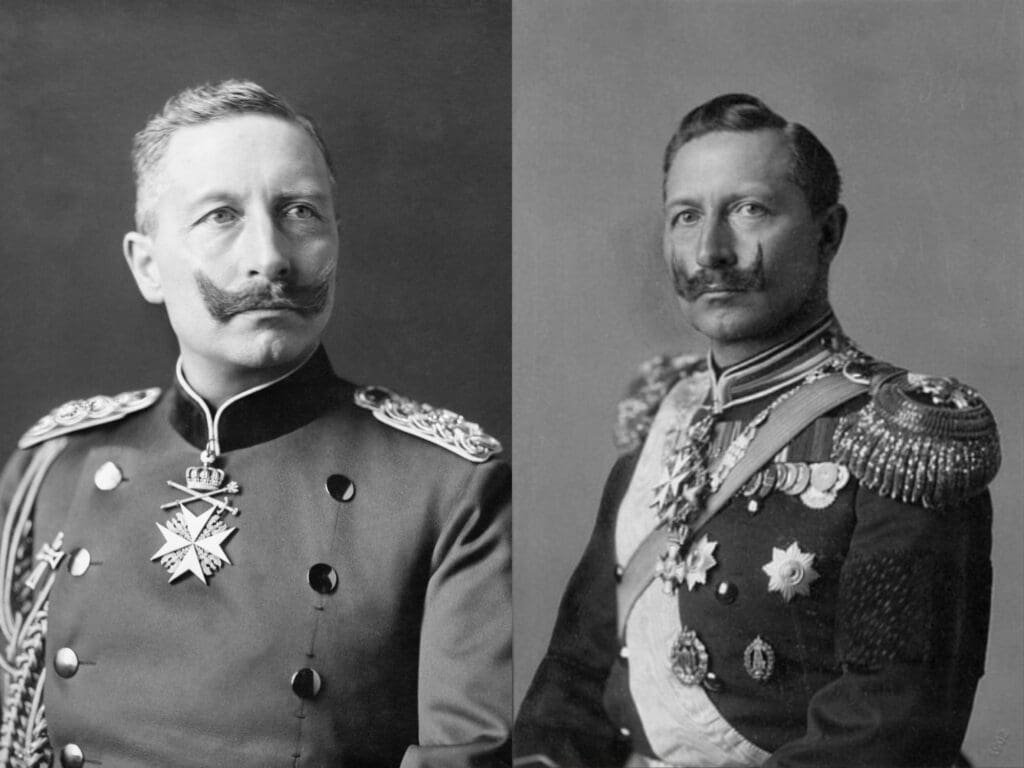
In 1907, Kaiser Wilhelm II, Emperor of Germany and King of Prussia, bought the Achilleion Palace from Sisi’s daughter, Gisela, Archduchess of Austria.
Kaiser Wilhelm II opened the Achilleion to fellow European royalty, such as his sister Sophia and brother-in-law Constantine. In 1913, the couple was crowned King Constantine I and Queen Sophia of Greece.
The German emperor also invited diplomats, scientists, archaeologists, and other noteworthy visitors to join him in Corfu.
He commissioned new statues, artwork, furniture, and other innovations for the estate. He also undertook archaeological excavations at the nearby Temple of Artemis.
Prior to the outbreak of World War I in 1914, Kaiser Wilhelm II took what was to be his final trip to Greece.
The outcome of World War I eventually led to the Kaiser’s abdication as the last Emperor of Germany and his exile to the Netherlands.
The Achilleion Palace in the 20th and 21st Centuries
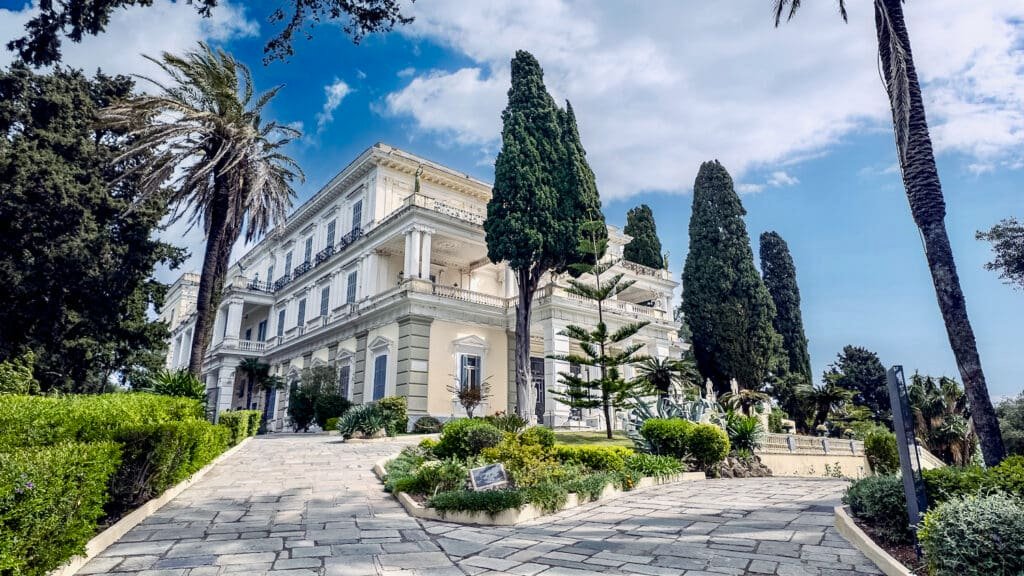
Throughout the 20th century, the Achilleion Palace changed hands and served different functions.
During World War I, the Achilleion Palace became a French and Serbian military hospital. In World War II, German and Italian troops occupied the property.
The post-war decades then saw major changes at the Achilleion Corfu. For instance, private owners converted the villa into a casino upstairs and a museum downstairs.
The Achilleion has further served as an international film location. Its most famous movie set so far is the casino scene in the 1981 James Bond film, For Your Eyes Only, starring Roger Moore.
With the Achilleion Palace once again under government management, the venue has hosted several important European Union summits, international conferences, and meetings.
Now in the 21st century, the Achilleion Palace, Imperial Gardens, and Achilleion Museum look ahead to a bright future.
In recent years, the Achilleion Palace has undergone extensive research, preservation, and restoration of the entire royal complex.
The Achilleion Palace Imperial Gardens
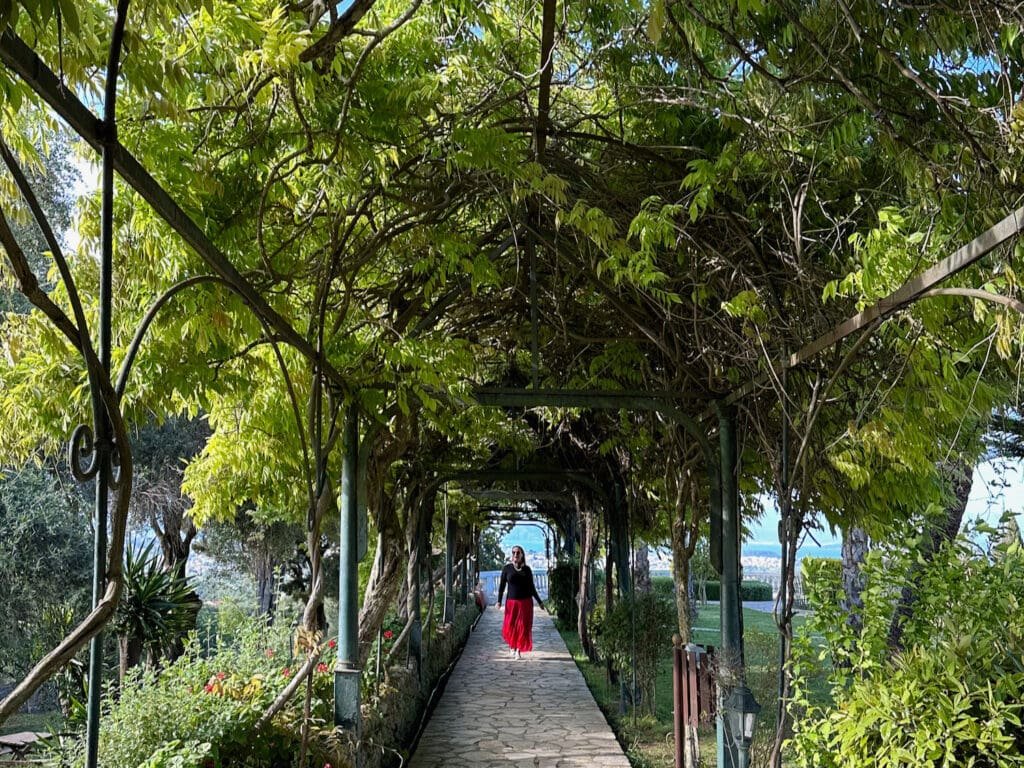
The Achilleion Palace possesses an imperial legacy unique among Greek landmarks. Likewise, the Achilleion Palace Imperial Gardens are quite unlike other Greek gardens.
At this time, because of the highly detailed and delicate work in progress, the palace interior and other estate buildings are closed to the public.
However, despite ongoing conservation and restoration, the Imperial Gardens remain open to visitors year-round.
While we haven’t yet been able to tour inside the palace, we’ve enjoyed wonderful days exploring the Imperial Gardens.
Each visit presents a new perspective, landscape, or statue to admire. Each visit imparts an evocative mood or inspires a memorable moment.
Although flowers and greenery vary during the four seasons, certain highlights of the Imperial Gardens are essential delights.
The following are some of the must-see sights, including our favorite works of art, in the Imperial Gardens.
Statue of Empress Sisi
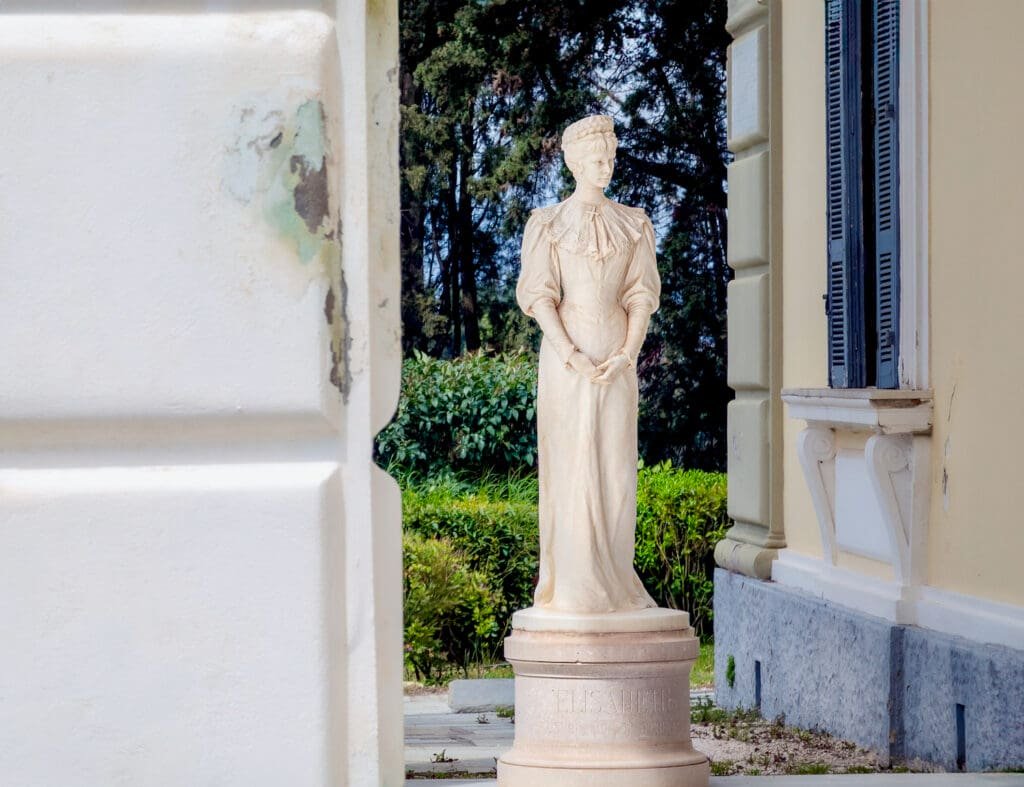
A marble statue of Empress Elisabeth of Austria stands under the pillared portico of the palace entrance.
The artist depicts the empress with her head bowed and hands clasped. She seems pensive in thought rather than poised to greet visitors.
Sisi’s famously long hair seems like a crown of braids around her aristocratic head.
Rather than a regal ballgown befitting a Habsburg empress, Sisi wears a modest gown appropriate to a mother in mourning.
Statue of Victorious Achilles
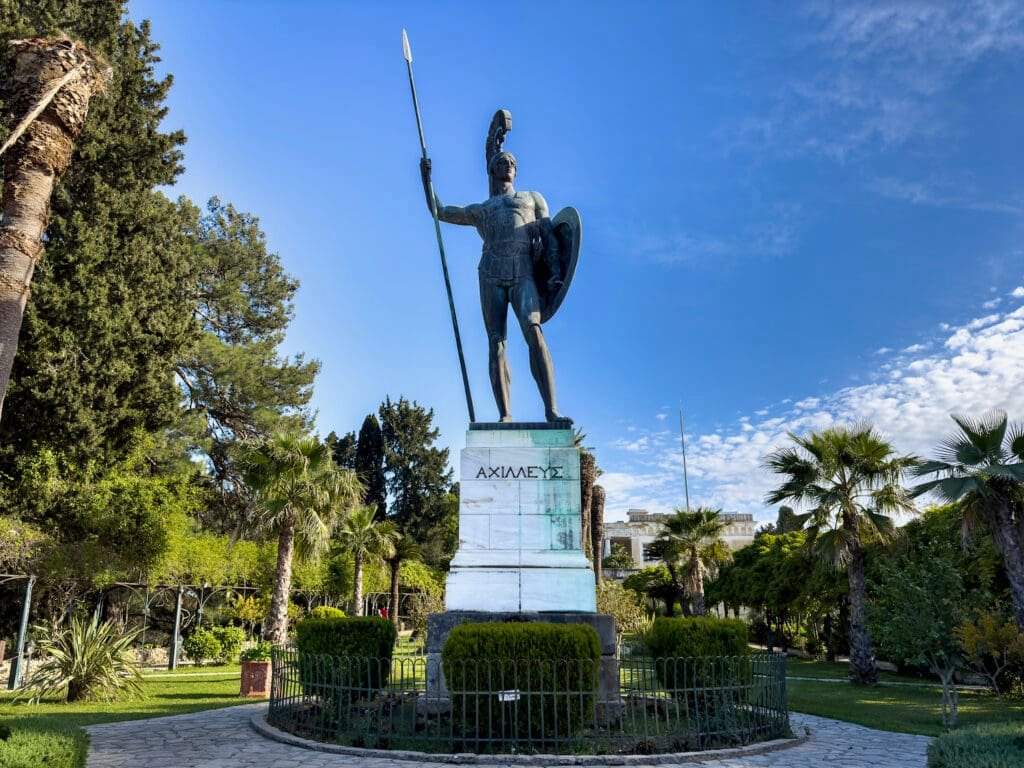
Kaiser Wilhelm II commissioned the colossal bronze statue of Victorious Achilles, which commands the Imperial Gardens.
German sculptor Johannes Gottfried Götz clads Victorious Achilles in a plumed hoplite helmet and armored hoplite uniform.
Standing tall, with his shield in one hand and his immense spear in the other, the larger-than-life warrior keeps vigilant watch.
When you stand on the vista terrace below Victorious Achilles, you’ll savor sweeping views over Corfu Island and the Ionian Sea.
Statue of Dying Achilles

Empress Sisi chose the 1884 sculpture, Dying Achilles, as the focal point on the ground level. Later, the magnificent work was moved to its current location.
German artist Ernst Gustav Herter captures Dying Achilles at the very moment when Paris’ fatal arrow pierced Achilles’ heel.
The sculptor conveys the heroic warrior’s doom with classical symmetry, exquisite form, and strong emotion.
You’ll find Dying Achilles in a prominent position on the next level before the Peristyle of the Muses.
The placement encourages you to contemplate the mighty Dying Achilles from every angle.
Statues of the Muses
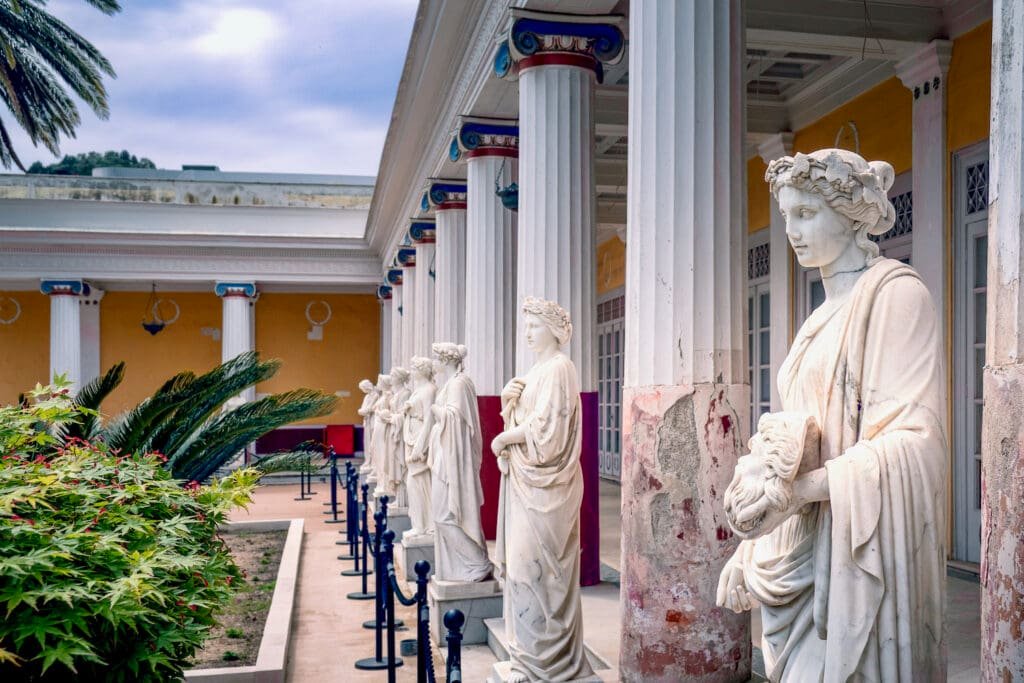
After your stroll through the gardens, ascend the grand outdoor staircase to the top level, the Peristyle of the Muses.
Apollo and Hermes welcome you to the inner garden courtyard framed with a lovely colonnade. A built-in banquette facing the colonnade is a popular photo backdrop.
Fluted Ionic columns with colorful capitals support the roof of the equally colorful L-shaped colonnade, which frames this al fresco art gallery.
Twelve marble maidens, all goddesses of Greek mythology, are the most important artistic feature here:
- Nine Muses who inspire the arts, sciences, and other creative, cultural, and intellectual pursuits.
- Three Graces who embody beauty, elegance, joy, happiness, abundance, and, of course, grace.
Additionally, the peristyle displays marble busts of Ancient Greek and Roman philosophers, poets, and politicians, and poets.
Besides the great minds of antiquity, such as Aristotle, Homer, Cicero, and Virgil, you may elsewhere discover great minds of other eras:
For example, the Bard of Avon, William Shakespeare, or the Romantic poet George, Lord Byron.
Tips to Visit the Achilleion, Corfu
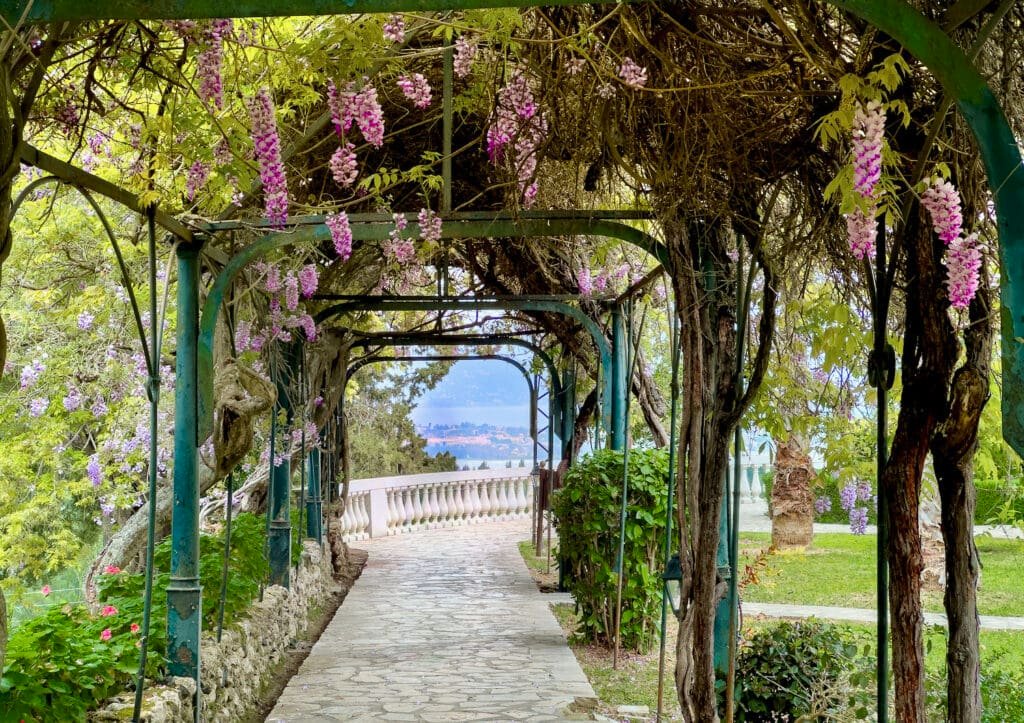
The Achilleion Palace is located in the quaint village of Gastouri. The route to Gastouri winds through scenic island roads, narrow streets, and olive groves.
Being that the Achilleion Palace is a 19th-century landmark undergoing restoration, please be aware that the estate has limited accessibility overall.
There’s a paved incline from the wrought-iron gate to the monumental manor entrance.
Several sculptures, informational signs, and restrooms are accessible on this fairly flat ground level.
However, visiting the Imperial Gardens entails historic stairs, uneven terrain, and ongoing construction work.
With this in mind, although the exterior paths are paved, we suggest wearing appropriate shoes for your tour of the Achilleion Imperial Gardens.
Achilleion Palace Garden (Κήπος Αχιλλείου) | National Road Corfu – Achilleion | 49084 Corfu, Greece
Opening Hours at the Achilleion, Corfu
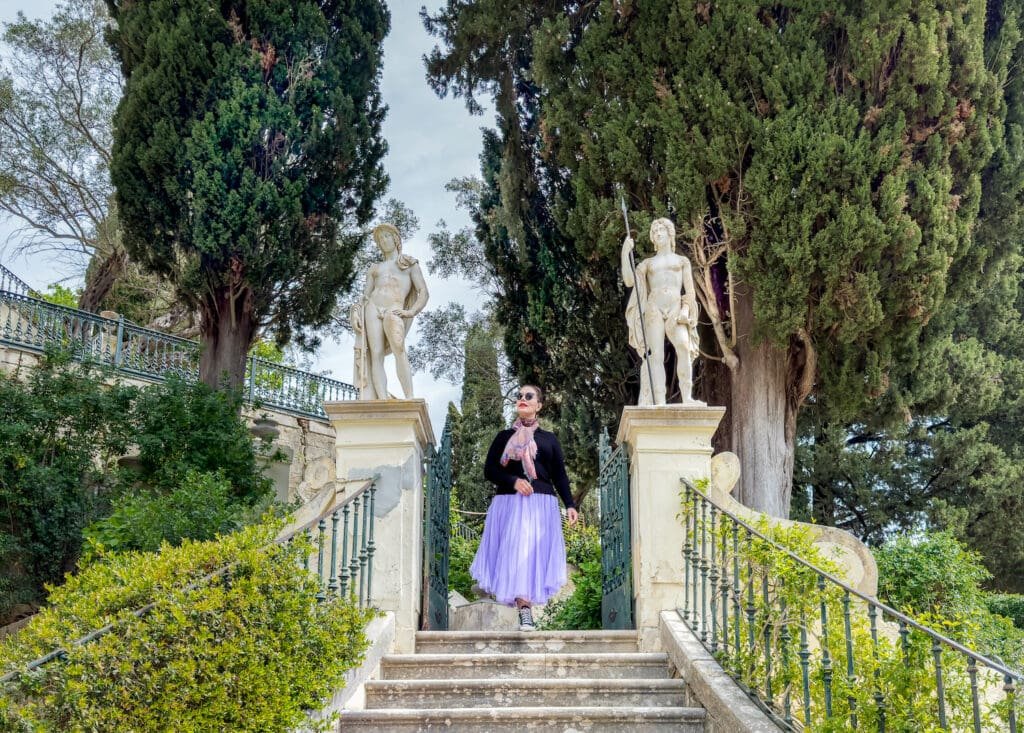
The Achilleion Palace Gardens are open daily throughout the year with the following schedule:
- In the spring, summer, and early fall, the Achilleion is open daily from 8 am to 8 pm (08:00 to 20:00) from April 1st to October 31st.
- During the late fall and winter, the Achilleion is open daily from 8 am to 4 pm (08:00 to 16:00) from November 1st to March 31st.
As mentioned above, only the Imperial Gardens and certain open outside areas are available to visitors.
Given that specification, unforeseen circumstances, such as inclement weather or limited staffing, may occasionally affect opening hours without notice.
Getting to the Achilleion, Corfu
The easiest and best way to visit the Achilleion Palace is to rent a car or take a guided tour with transportation.
A car rental or tour transportation further allows you to extend your excursion to a half-day or full-day trip. You can combine the Achilleion with other wonderful things to do on Corfu.
Let’s use the international airport and the main square in Corfu Town as the standard point of reference for approximate driving distance:
- Between Corfu International Airport and the Achilleion Palace, the driving distance is about 5.5 miles (8.8 km).
- From Spianada Square in the heart of Corfu Town to the Achilleion Palace, the driving distance is about 6 miles (10 km).
The airport offers the most car rental agencies and the widest variety of rental cars on the island.
Check available dates and best prices, then book your Corfu car rental:
Here’s why we’re fans of guided tours with certified local tour guides:
Firstly, a guided tour with a professional local tour guide provides a depth of information that enriches your understanding. The level of expert insight can further elevate your experience.
Secondly, it’s certainly nice to leave the driving in professional hands. While you sit back, relax, take in the views, and enjoy the experience!
•••
Interactive Map of Corfu, Greece
Sources and Resources
Djinis, Elizabeth. “The Many Myths of Empress Elisabeth of Austria, the 19th-Century Royal Whose Beauty and Tragic Death Transformed Her into a Legend,” Smithsonian Magazine, April 28th, 2025.
Goldstone, Nancy, The Rebel Empresses: Elisabeth of Austria and Eugénie of France, Power and Glamour in the Struggle for Europe. Little, Brown, and Company, 2025.
Haderer, Stefan. Under the Spell of a Myth: Empress Sisi in Greece. KDP Publishing, 2022.
Hamann, Brigitte, The Reluctant Empress: A Biography of Empress Elisabeth of Austria. Faber and Faber, 2011.
Homer, The Iliad. Translated by Emily Wilson, W.W. Norton and Company, 2023.
Karanastasi, Pavlina. “Ο «κήπος των Μουσών» στο Αχίλλειο της Κέρκυρας και ο γλυπτός του διάκοσμος (The ‘Garden of the Muses’ at the Achilleion of Corfu and its sculptural decoration), Περιοδικό Μουσείο Μπενάκη. Benaki Museum, Athens, Greece, 2011
Martin, Natalie. “Under the Spell of a Myth: Empress Sisi in Greece,” Greek City Times. November 4th, 2022.
Check Out More Recommendations
GET: Now that you’re ready to visit the Achilleion Palace in Corfu, Greece, get your exclusive free storytelling guide to tell your travel stories easily.
•••
The Achilleion Palace FAQs
When will Achilleion Palace reopen?
The Achilleion Palace interior is currently closed to visitors due to preservation, protection, and restoration work. At this time, the Achilleion staff have not advised a re-opening date. However, the Achillieon Imperial Gardens are now open daily throughout the year.
Is Achilleion Palace open?
The Achilleion Imperial Gardens are open daily to visitors during the year. Due to ongoing conservation and construction, the Achilleion Palace interior and other buildings on the estate will re-open at a future date to be determined.
Where is the Achilleion?
The Achilleion Palace and Imperial Gardens is located in the village of Gastouri on the Greek island of Corfu in the Ionian Sea.
Is the Achilleion Palace worth visiting?
The Achilleion Palace and Imperial Gardens is well worth visiting. As the Greek summer residence of two European monarchs, the Achilleion Palace has an imperial history unique among Greek landmarks. Empress Elisabeth of Austria created the Achilleion as her private family retreat. In 1907, Kaiser Wilhelm II, the last Emperor of Austria, purchased the Greek villa from the heirs of Empress Sisi. Today, the royal heritage of regal beauty, art, and culture continues at the Achilleion, Corfu.

All opinions expressed are Spotlight Sojourns’ own.
All content and images are original, created with care by yours truly, Marilee Kostadimas and Paul Kostadimas. We’re the Hidden Gemologists® of Spotlight Sojourns: Award-winning travel experts and slow travel storytellers. Because slow travel is meaningful travel, part of a meaningful life. And stories enrich the meaning.


